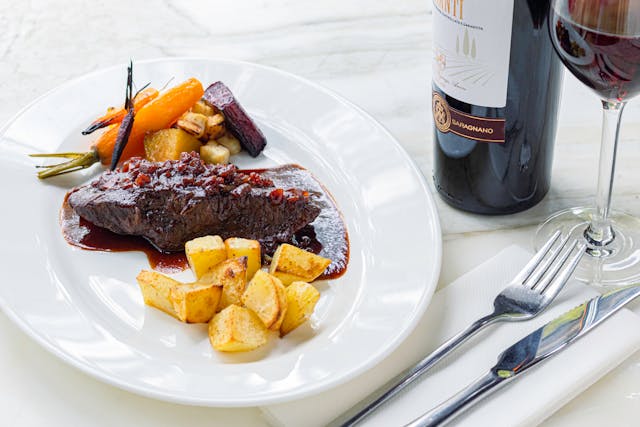In a feast for taste buds, matching wine and food is undoubtedly an art. It can not only enhance the dining experience, but also deepen people’s understanding of food and wine culture. Here’s a detailed look at unlocking the code for wine and food pairing:
1. Understand the basic characteristics of wine and food
Classification and characteristics of wine:
Liquor: According to the aroma type, it can be divided into sauce-flavor type, strong-flavor type, light-flavor type, etc. Each flavor type has its own unique aroma and taste.
Red wine: elegant and romantic, suitable for pairing with a variety of cuisines.
Rice wine: Mild and nourishing, it has a unique flavor.
Classification and characteristics of food:
Greasy dishes: such as braised pork, fried food, etc., taste greasy.
Light dishes: such as seafood, vegetables, etc., have a light taste.
Special dishes: such as Sichuan cuisine, northwest cuisine, etc., with regional characteristics.
2. Principles of pairing wine and food
Fragrance match:
Maotai-flavored white wine is suitable for dishes with thicker flavors, such as braised pork, beef with soy sauce, etc.
Strong-flavor liquor is suitable for neutralizing the fishy smell of seafood and the greasiness of poultry.
Light-flavored white wine is suitable for pairing with lighter and more refreshing dishes such as salads and vegetables.
Complementary flavors:
Greasy dishes can be paired with refreshing white or red wine to reduce the greasiness.
Light dishes can be paired with rich white wine or rice wine to enhance the flavor.
Regional characteristics:
Wine and food pairings in different regions often have local regional characteristics and cultural connotations. For example, Sichuan’s Maotai-flavor liquor complements local Sichuan cuisine.
3. Specific matching cases
Liquor and food:
Maotai-flavor liquor: such as Maotai, paired with rich dishes such as braised pork and Kung Pao chicken.
Strong-flavor liquor: such as Wuliangye, paired with steamed hairy crabs, steamed seabass and other seafood dishes.
Light-flavor liquor: such as Fenjiu, paired with light dishes such as cold cucumbers and boiled shrimps.
Wine and food:
Red wine is suitable for pairing with ingredients such as red meat (such as beef and lamb) and cheese. Its rich fruit flavor and tannin can blend with the fat and protein of these ingredients.
Rice wine and food:
Rice wine is suitable for pairing with seafood, poultry and other ingredients. Its mild taste and unique aroma can enhance the flavor of these ingredients.
4. Precautions
Drink in moderation: No matter what kind of food is paired with it, drink it in moderation to avoid excessive amounts that may cause physical discomfort.
Personal taste: You also need to consider personal taste preferences when pairing, and choose a matching method that suits you.
Cultural background: Understanding the cultural background of different wines and foods can better understand the art and connotation of their pairings.
To sum up, the matching of wine and food is a science full of art and culture. By understanding the basic characteristics of wine and food, following the principles of pairing, referring to specific pairing cases and paying attention to relevant matters, we can enjoy the pleasure and satisfaction brought by food and wine in a feast for our taste buds.

